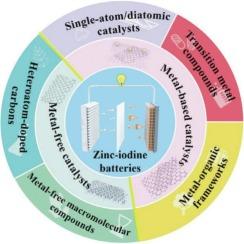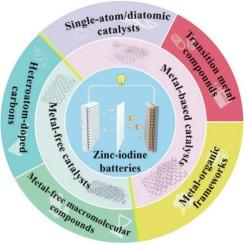锌碘电池中的电催化剂:理论见解和材料设计
IF 23.5
1区 化学
Q1 CHEMISTRY, INORGANIC & NUCLEAR
引用次数: 0
摘要
含水锌碘(Zn-I2)电池已经成为电网级电化学储能的一个引人注目的解决方案。电催化剂是解决锌- i2电池困境的关键,特别是在氧化还原反应动力学缓慢和恶化的穿梭效应方面。开发了一系列电催化剂来促进碘的转化;然而,它们的设计理念和催化机理仍有待进一步研究。本文综述了锌离子电池电催化剂的研究进展,从理论认识到催化剂的合成。从面临的挑战、评价指标和反应机理出发,阐述了无金属和金属基阴极电催化材料的重要研究成果,对理论见解、设计理念、合成方法、反应机理等进行了深入探讨。最后,对锌离子电池电催化剂的发展前景进行了展望。本文综述为设计先进的电催化剂,提高锌- i2电池的电化学性能提供了理论基础和新的指导。本文章由计算机程序翻译,如有差异,请以英文原文为准。


Electrocatalysts in zinc‑iodine batteries: theoretical insights and material design
Aqueous zinc‑iodine (Zn-I2) batteries have emerged as a compelling solution for grid-scale electrochemical energy storage. Electrocatalysts are crucial to address the dilemma of Zn-I2 batteries, especially in terms of the sluggish redox reaction kinetics and the deteriorative shuttle effect. A range of electrocatalysts has been developed to facilitate iodine conversion; however, their design concepts and catalytic mechanisms remain to be further understood. This review summarizes the current advances of electrocatalysts for Zn-I2 batteries from theoretical insights to catalyst synthesis. Starting from the challenges, evaluation index and reaction mechanism, important achievements in metal-free and metal-based cathodic electrocatalytic materials are elaborated, providing an in-depth discussion of theoretical insights, design concepts, synthetic methods, and reaction mechanisms. Finally, the prospect for the development of electrocatalysts for Zn-I2 batteries is envisioned. This review provides theoretical foundations and new guidance for designing advanced electrocatalysts and improving the electrochemical performance of Zn-I2 batteries.
求助全文
通过发布文献求助,成功后即可免费获取论文全文。
去求助
来源期刊

Coordination Chemistry Reviews
化学-无机化学与核化学
CiteScore
34.30
自引率
5.30%
发文量
457
审稿时长
54 days
期刊介绍:
Coordination Chemistry Reviews offers rapid publication of review articles on current and significant topics in coordination chemistry, encompassing organometallic, supramolecular, theoretical, and bioinorganic chemistry. It also covers catalysis, materials chemistry, and metal-organic frameworks from a coordination chemistry perspective. Reviews summarize recent developments or discuss specific techniques, welcoming contributions from both established and emerging researchers.
The journal releases special issues on timely subjects, including those featuring contributions from specific regions or conferences. Occasional full-length book articles are also featured. Additionally, special volumes cover annual reviews of main group chemistry, transition metal group chemistry, and organometallic chemistry. These comprehensive reviews are vital resources for those engaged in coordination chemistry, further establishing Coordination Chemistry Reviews as a hub for insightful surveys in inorganic and physical inorganic chemistry.
 求助内容:
求助内容: 应助结果提醒方式:
应助结果提醒方式:


